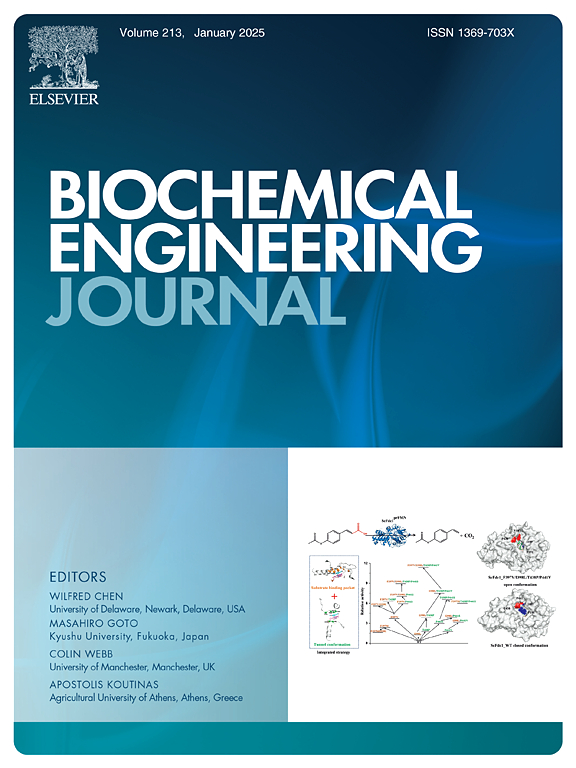Responses of nitrogen removal, microbial community and antibiotic resistance genes to biodegradable microplastics during biological wastewater treatment
IF 3.7
3区 生物学
Q2 BIOTECHNOLOGY & APPLIED MICROBIOLOGY
引用次数: 0
Abstract
Biodegradable plastics decompose more easily into microplastics (MPs) as alternatives to traditional plastics. However, the effects of biodegradable microplastics (BMPs) on the aerobic biological treatment process in activated sludge need further investigation. This study compared the effects of three BMPs (Polylactic acid (PLA), Polyhydroxyalkanoate (PHA) and Polybutylene succinate (PBS)) with 1, 10 and 50 mg/L on nitrogen removal, microbial community and antibiotic resistance genes (ARGs) in activated sludge. The results demonstrated that 10 and 50 mg/L PHA and 50 mg/L PLA enhanced specific nitrate and specific nitrite reduction rates, promoting total nitrogen removal. The positive effects on denitrification-related functional genes (such as napA, nirK, nirS) were also identified. Additionally, 10 mg/L PLA and PHA stimulated the production of loosely bound extracellular polymeric substances (EPS). However, 50 mg/L PLA and PHA decreased the tightly and loosely bound EPS contents. The response of nitrogen removal and EPS were attributed to the shifts of dominant bacteria abundance including Bacteroidota, Chloroflexi and Acidobacteriota. Moreover, PHA and PLA promoted the abundance of ARGs and intI1 in activated sludge, particularly at high concentrations. However, PBS did not affect the nitrogen removal, EPS and microbial communities. The results might shed light on the influence of BMPs on activated sludge.
废水生物处理过程中氮去除、微生物群落和抗生素耐药基因对生物降解微塑料的响应
作为传统塑料的替代品,可生物降解塑料更容易分解成微塑料(MPs)。然而,生物降解微塑料(BMPs)对活性污泥好氧生物处理过程的影响还有待进一步研究。本研究比较了1、10和50 mg/L的3种bmp(聚乳酸(PLA)、聚羟基烷酸酯(PHA)和聚丁二酸丁酯(PBS))对活性污泥中氮的去除、微生物群落和抗生素抗性基因(ARGs)的影响。结果表明,10和50 mg/L PHA和50 mg/L PLA可提高特定硝酸盐和特定亚硝酸盐的还原率,促进总氮的去除。对反硝化相关功能基因(如napA, nirK, nirS)的积极影响也被确定。此外,10 mg/L PLA和PHA刺激了松散结合的细胞外聚合物(EPS)的产生。50 mg/L PLA和PHA降低了紧密结合和松散结合的EPS含量。除氮和EPS的响应归因于优势菌群(拟杆菌门、绿杆菌门和酸杆菌门)丰度的变化。此外,PHA和PLA促进活性污泥中ARGs和intI1的丰度,特别是在高浓度时。PBS对氮的去除率、EPS和微生物群落没有影响。该结果可能有助于揭示bmp对活性污泥的影响。
本文章由计算机程序翻译,如有差异,请以英文原文为准。
求助全文
约1分钟内获得全文
求助全文
来源期刊

Biochemical Engineering Journal
工程技术-工程:化工
CiteScore
7.10
自引率
5.10%
发文量
380
审稿时长
34 days
期刊介绍:
The Biochemical Engineering Journal aims to promote progress in the crucial chemical engineering aspects of the development of biological processes associated with everything from raw materials preparation to product recovery relevant to industries as diverse as medical/healthcare, industrial biotechnology, and environmental biotechnology.
The Journal welcomes full length original research papers, short communications, and review papers* in the following research fields:
Biocatalysis (enzyme or microbial) and biotransformations, including immobilized biocatalyst preparation and kinetics
Biosensors and Biodevices including biofabrication and novel fuel cell development
Bioseparations including scale-up and protein refolding/renaturation
Environmental Bioengineering including bioconversion, bioremediation, and microbial fuel cells
Bioreactor Systems including characterization, optimization and scale-up
Bioresources and Biorefinery Engineering including biomass conversion, biofuels, bioenergy, and optimization
Industrial Biotechnology including specialty chemicals, platform chemicals and neutraceuticals
Biomaterials and Tissue Engineering including bioartificial organs, cell encapsulation, and controlled release
Cell Culture Engineering (plant, animal or insect cells) including viral vectors, monoclonal antibodies, recombinant proteins, vaccines, and secondary metabolites
Cell Therapies and Stem Cells including pluripotent, mesenchymal and hematopoietic stem cells; immunotherapies; tissue-specific differentiation; and cryopreservation
Metabolic Engineering, Systems and Synthetic Biology including OMICS, bioinformatics, in silico biology, and metabolic flux analysis
Protein Engineering including enzyme engineering and directed evolution.
 求助内容:
求助内容: 应助结果提醒方式:
应助结果提醒方式:


